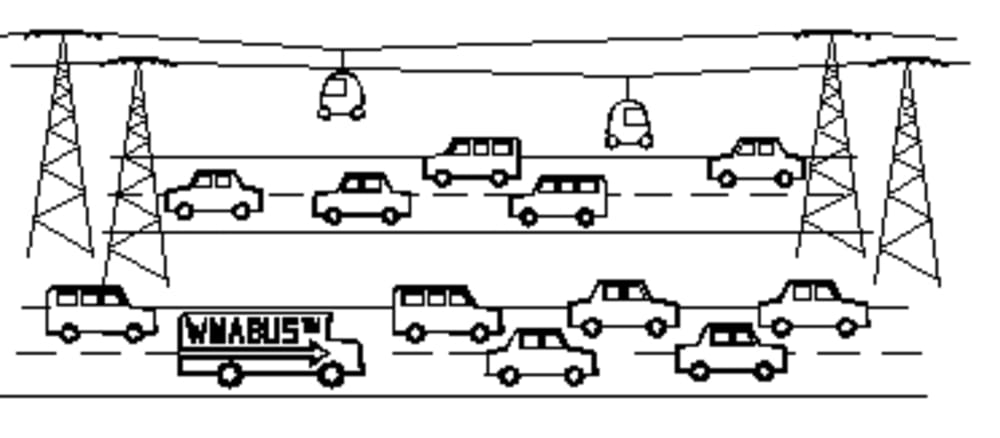PROBLEM
The mass transit systems in the United States remain unavailable to most of the commuting public who live and work too far from mass transit lines. Near major urban areas, their commuting path usually takes them parallel to mass transit routes for much of their route, but their homes as well as their places of work are too diverse to make use of mass transit connections.
SOLUTION
A small electric commuter (one or two passenger) vehicle with very limited range coupled with a Propulsion And Delivery (PAD) system that follows major arteries would allow commuters to drive from their homes to the PAD system, which would convey them and their vehicles the largest portion of their commute. Upon exiting the PAD system, they could drive the small remaining distance to their work. The PAD system would be primarily implemented on the existing limited access roadways, making use of the presently unoccupied medians. Thus right-of-way issues and site preparation would be minimal Other aspects of the PAD system would be:
Vehicles would be required to comply with PAD standards. Compliance and operational integrity would be verified before entry to the PAD system.
The PAD system would be electronically controlled to avoid bottlenecks and to insure safety. This control would allow for entry and exit time slot reservations, insuring passage through the PAD system without unforeseen delays.
The PAD system routes would be along the paths of major roadways, linking them easily to existing smaller roads. Their smaller size would ease congestion on the roadways and on parking facilities at their destinations.
IMPLEMENTATION
As a conceptional approach to understanding the the PAD system, imagine an enclosed ski lift gondola with wheels. Big enough for two people, it could navigate streets and roads for limited distances, providing a private space for the passengers during the commute. Now, imagine a ski lift running down the median of a divided highway. The individual vehicle arrives at an entry point. At the first available space, the vehicle is merged onto the PAD system. The vehicle is conveyed along and disengaged at the predetermined exit point where it is free to drive to its ultimate destination.
While the above description is easy to envision because it makes use of familiar systems and technologies, it would be impractical for long distance travel. A more practical implementation is possible using linear motor technology on elevated paths.
LOGISTICS
All of the technologies required to build and implement the PAD system are readily available today. Commuters would defray the cost of PADS installation through usage fees costing less than their current commuting costs. PAD vehicles would be less expensive to buy and maintain than vehicles currently in use for commuting.
BENEFITS
Decreased commute expenses.
Fewer commuter delays.
Private hands-free commute environments with communications access.
Lower energy consumption.
Reduction in congestion of the major roadways.
Increased jobs for PAD system design and installations.
New business for automobile manufacturers.
Like this entry?
-
About the Entrant
- Name:Wayne Miller
- Type of entry:individual
- Software used for this entry:openoffice, ACAD
- Patent status:none

